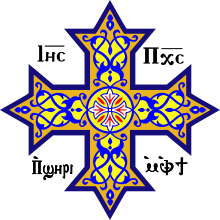Saint Amun
| Saint Ammon | |
|---|---|
_3876_-_Copy.jpg) | |
| Hermit | |
| Born | Mariotis, Egypt |
| Died | Scetes, Egypt |
| Venerated in |
Eastern Orthodox Church Oriental Orthodox Churches Roman Catholic Church |
| Feast | 4 October (20 Pashons) |
Ammon, Amun (Coptic: Ⲁⲃⲃⲁ Ⲁⲙⲟⲩⲛ), Ammonas (Greek: Ἀμμώνας), Amoun (Ἀμοῦν), or Ammonius the Hermit (/əˈmoʊniəs/; Greek: Ἀμμώνιος) was a 4th-century Christian ascetic and the founder of one of the most celebrated monastic communities in Egypt.[1] He was subsequently declared a saint. He was one of the most venerated ascetics of the Nitrian Desert, and Saint Athanasius mentions him in his life of Saint Anthony. His name is the same as that of the ancient Egyptian god Amun.
Pushed into marriage by his family at the age of 20, he managed to persuade his bride to take a vow of chastity together with him by the authority of St. Paul's Epistle to the Corinthians.[2][3] They lived together this way for 18 years, when at her wish, they parted, and he retired to Scetis and Mt. Nitria, to the south of Lake Mareotis, where he lived 22 years, visiting his sister-wife twice a year.[3][4][5] She had founded a convent in her own house.
He cooperated with Saint Anthony and gathered his monks under his direct supervision, thus forming a monastery from sole hermits. Traditionally, he is supposed to have been the first hermit to have established a monastery, known as Kellia, near Nitria. This is by no means verifiable, but it is more certain that Amun's piety and fame drew others to the region. He is considered to have died at the age of 62 years. His feast day is October 4 in the Eastern Orthodox, Byzantine Catholic, and Roman Catholic Churches. His feast in the Coptic Orthodox Church is on 20 Pashons.
He died before St. Anthony the Great from whom there is an epistle to him.[6] that is, before the year 365, for the latter asserted that he "saw the soul of Amoun borne by angels to heaven",[7] and as St. Athanasius's history of St. Antony preserves the order of time, he died perhaps about 320. There are generally seventeen or nineteen Rules of Asceticism (κεφάλαια) ascribed to him; the Greek original exists in manuscript;[8] they were published in the Latin version of Gerardus Vossius.[9] Twenty-two Ascetic Institutions of the same Amoun, or one bearing the same name, exist also in manuscript.[8] There is a collection of his letters in the Patrologia Orientalis, volume 10/6[10].
References
- ↑ Christie, Albany James (1867). "Ammonas". In William Smith. Dictionary of Greek and Roman Biography and Mythology. 1. Boston: Little, Brown and Company. p. 145.
- ↑ Sozom. Hist. Eccl. i. 14
- 1 2 Socr. Hist. Eccl. iv. 23
- ↑ Pallad. Hist. Laus. c. 7
- ↑ Ruffin. Vit. Patr. c. 29
- ↑ S. Athan. Opp. vol. i. pt. 2, p. 959, ed. Bened.
- ↑ Vit. S. Antonii a S. Athanas. § 60
- 1 2 Lambecius, Commentariorum de augustissima bibliotheca Caesarea Vindobonensi lib. iv. cod. 156, No. 6
- ↑ Gerardus Vossius, Biblioth. PP. Ascetica vol. ii. p. 484, Paris 1661
- ↑ St. Amoun's Letters translated to Arabic
Bibliography


